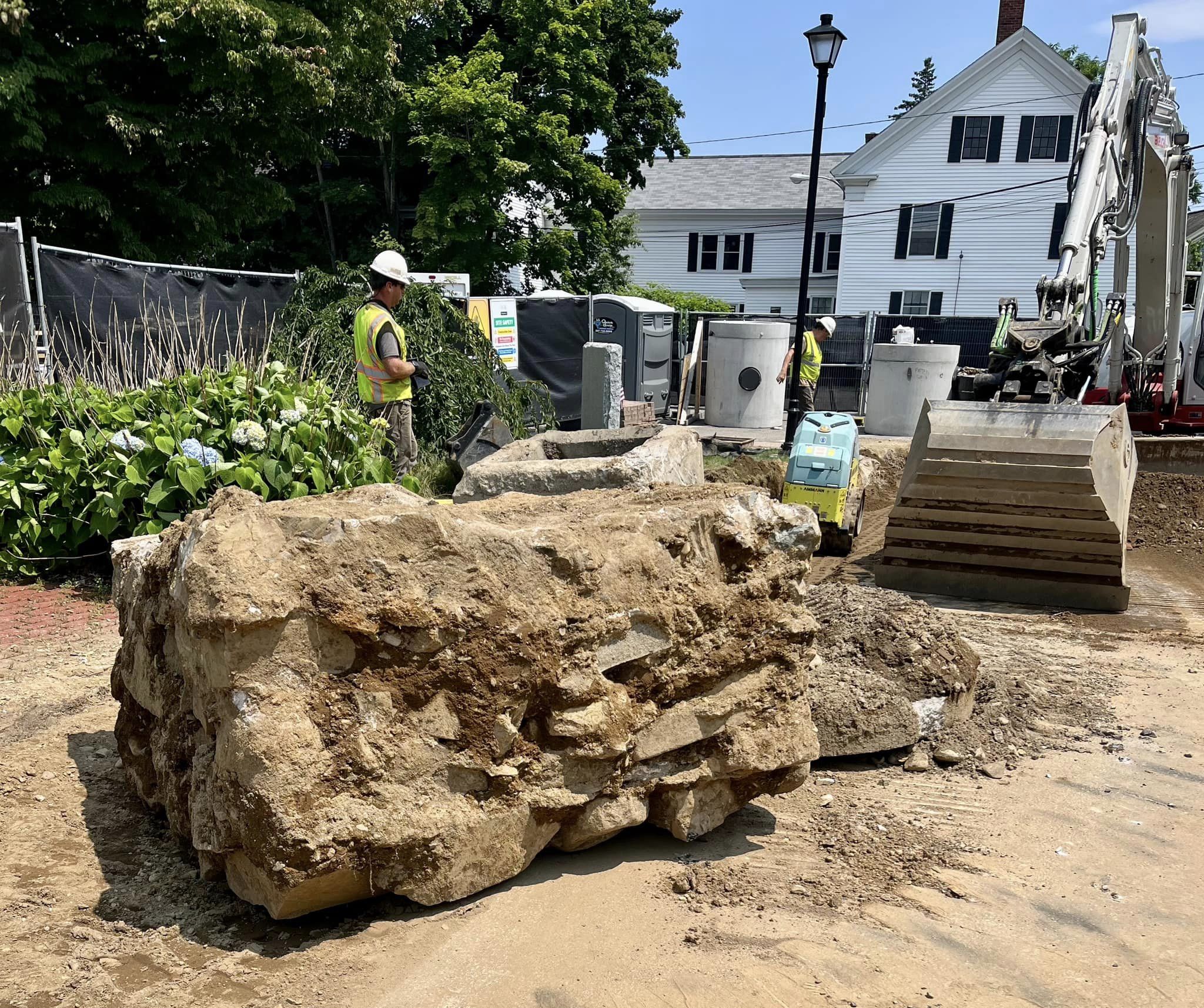by Michael Dow
Two cannon foundations found

A number of years ago when I started to research York’s war monuments, Old York Historic Librarian Emeritus Ginny Spiller (RIP) told me that somewhere she had seen a picture of two large canons, sitting left and right of the Town Hall’s south facing front walk. She explained that these cannons looked like the cannon on Gaol Hill. Much time had passed and Ginny could not remember where she had seen that picture and its whereabouts remains a mystery to this day.
I learned never to discount anything Ginny said and so eyes have always been open for evidence concerning any mention of old artillery mounted by the town hall. Others were informed about this nagging interest, with Selectman and First Parish Cemetery Director Todd Frederick being one.
In the midst of last week’s excavations in the front of the old town hall, I received a picture from Todd of an old, large masonry block made from what the on-site archeologist referred to as loose stone held together by a “lime-based mortar.” Todd said two of these blocks had just been dug up! I quickly drove down and sure enough, there were the foundation blocks for two granite cannon mounts or “carriages” as they were called and another big score for Ginny Spiller’s memory!
A September 5th, 1942 Portland Press article explains how three big Civil War cannons came to York;
“Before the erection of the building on the Kittery Navy Yard where in 1905 the famous treaty between Russia and Japan was signed there were several of these old cannon that had mounted the place in strategic points around the Navy Yard. The room they took up was needed. Members of the Grand Army of the Republic in adjacent towns were notified that these cannon might be theirs for the asking. The Town of York, through it’s post fell heir to three of the cannon. One was placed on a triangle in the center of the square in York Village, where it remained until GAR veterans wished to use that particular spot on which to erect a Civil War memorial. The other two mounted on granite carriages, were placed either side of the entrance to the town Hall, where they the delight of small boys on the glorious fourth as they attempted to shoot off crackers through the mouth of the cannon, until the holes were cemented.”
The Merriam-Webster Dictionary lists both “cannon” and “cannons” as the plural forms of the noun “cannon,” which is a good point to remember when researching artillery.
The building referred to in the article was known as the General Stores Building and it was built in 1903. This building is now known as the Main Administration Building. We have two newspaper articles from two different papers and a very credible book published by Old York Historic indicating these three cannons were in York by 1899. The former custodian of the National Registry of Known Surviving Civil War Artillery had recorded that three 100-pdr Navy Parrot Rifles were donated in 1897 to “village selectmen” in York, Maine.
For York and other towns that did not have enough Civil War veterans to warrant a Grand Army of the Republic (GAR) post, an alternative was employed. The York Village Veterans and Sons of Veterans Association was the group the article speaks of. The Soldiers’ Monument was erected and dedicated on Memorial Day, June 30, 1906 with none other than Joshua Lawrence Chamberlain being the key note speaker. Chamberlain was the officer leading the 20th Maine in their pivotal victory on Little Round Top at the battle of Gettysburg in 1863, the same year our one remaining cannon was made. General Chamberlain was awarded the Congressional Medal of Honor, a four-time governor of the state of Maine, president of Bowdoin College and a not infrequent visitor to York.
Although we do not know the exact date when the two cannons were mounted in front of the town hall, evidence indicates by 1900 both were in place. We also do not know when they were taken down and moved to the pine knoll, just to the left rear of the brick Receiving Tomb in back of the First Parish Cemetery. There they sat until the 1942 scrap drive when they were taken to be melted down for use in another war.
The two granite mounts or carriages were later sold (without permission) to Fort McClary. However, they proved to be unsuitable for that facilities’ different styled cannons so they were used as ends for a rough pine bench. Found by this researcher in July of 2016, they were repurchased by the First Parish Cemetery and now rest on Ceremonial Circle.
In the spring of 1905, the single 6.4” Parrott Rifle Naval cannon #206 and its granite carriage were moved to the side of that ever-shrinking grass triangle and the Soldiers’ Monument was erected on the same spot the cannon formerly occupied. In all likelihood, #206 had a similar loose stone and lime-based mortar foundation which was most likely broadened to accommodate the larger footprint of the Soldiers’ Monument. This would explain the observed degradation of that Monument’s lower base and the necessity to move the monument onto a more stable foundation.
Later in 1906, our one remaining cannon was moved to its present location on Gaol Hill. Where #206 served during the Civil War remains a mystery as are the serial numbers of the two, town hall/scrap drive cannons.
c. Michael Dow July 15, 2023
